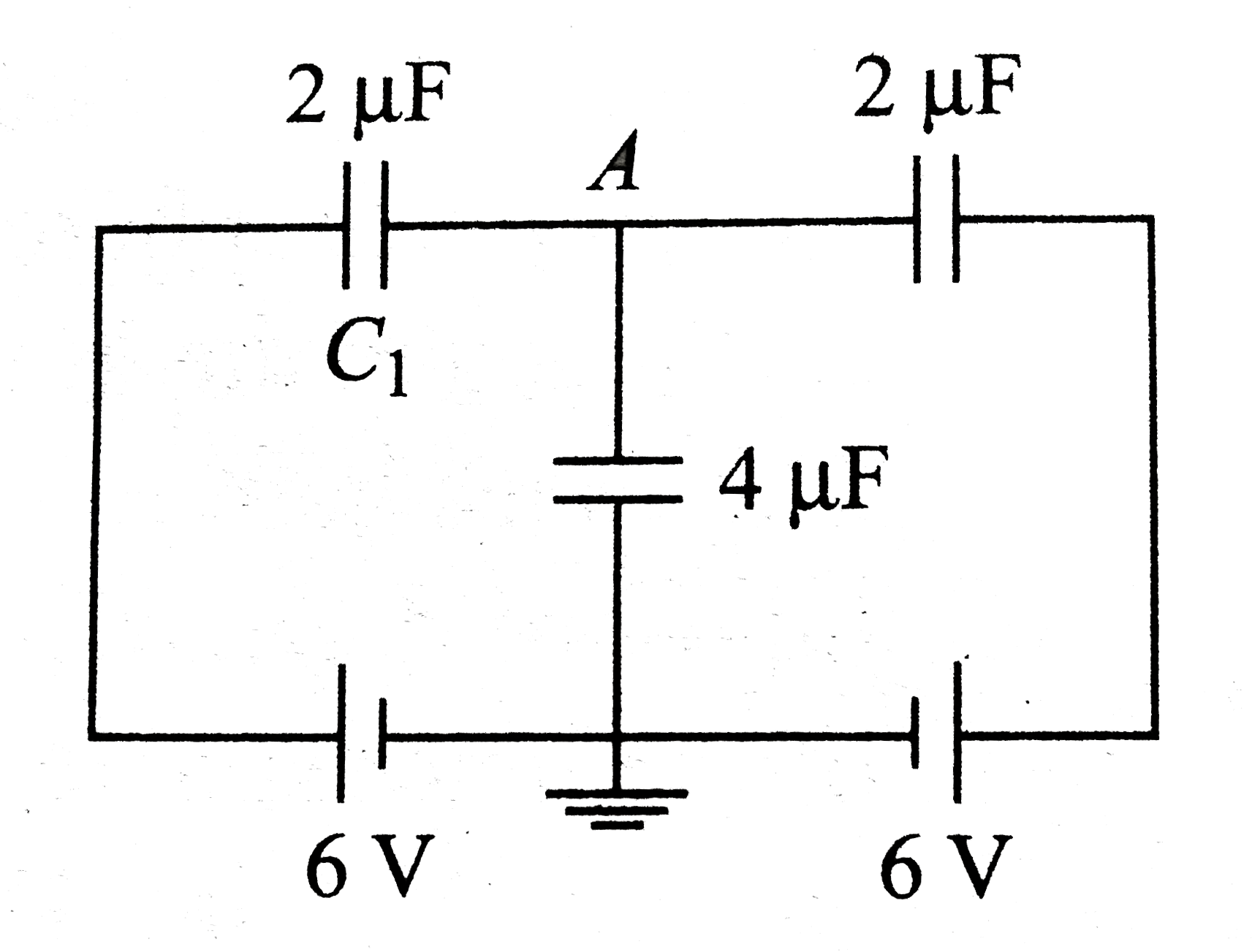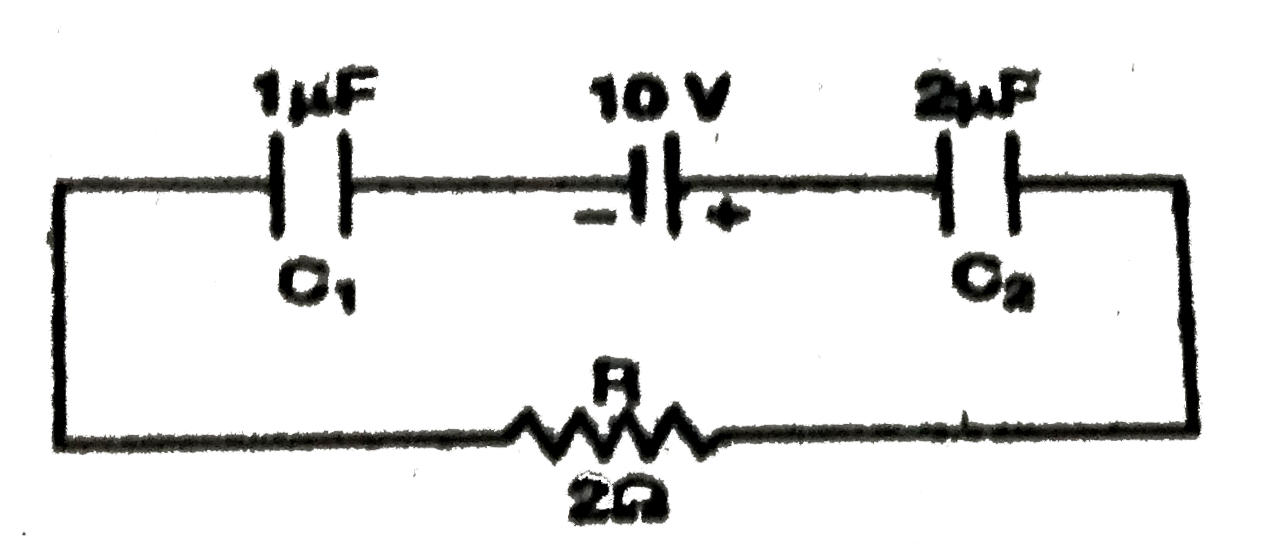Effective capacitance of parallel combination of two capacitors C1andC2 is 10μF. When the capacitors are individually connected to a voltage source of 1V, the energy stored in the capacitor C2 is 4 times of C1. If these capacitors are connected in series, their effective capacitor will be: lt
Option1 3.2μF
Option2 4.2μF
Option3 1.6μF
Option4 8.4μF
The correct Answer is:3
To solve the problem step by step, we will follow the information provided in the question and derive the required values.
Step 1: Understand the effective capacitance in parallel
When two capacitors C1 and C2 are connected in parallel, the effective capacitance Ceff is given by the formula:
Ceff=C1+C2
According to the problem, the effective capacitance is 10μF:
C1+C2=10μF(Equation 1)
Step 2: Use the energy stored in capacitors
The energy stored in a capacitor is given by the formula:
E=12CV2
When each capacitor is connected to a voltage source of 1V:
- The energy stored in capacitor C1 is:
E1=12C1(12)=12C1
- The energy stored in capacitor C2 is:
E2=12C2(12)=12C2
According to the problem, the energy stored in capacitor C2 is 4 times that in C1:
E2=4E1
Substituting the expressions for E1 and E2:
12C2=4(12C1)
This simplifies to:
C2=4C1(Equation 2)
Step 3: Substitute Equation 2 into Equation 1
Now we can substitute C2 from Equation 2 into Equation 1:
C1+4C1=10μF
This simplifies to:
5C1=10μF
Thus, we find:
C1=2μF
Step 4: Calculate C2
Using the value of C1 in Equation 2:
C2=4C1=4×2μF=8μF
Step 5: Calculate the effective capacitance when connected in series
When capacitors are connected in series, the effective capacitance Ceff is given by:
1Ceff=1C1+1C2
Substituting the values of C1 and C2:
1Ceff=12μF+18μF
Finding a common denominator (8):
1Ceff=48μF+18μF=58μF
Thus, taking the reciprocal gives:
Ceff=85μF=1.6μF
Final Answer
The effective capacitance when the capacitors are connected in series is:
Ceff=1.6μF
When two capacitors C1 and C2 are connected in parallel, the effective capacitance Ceff is given by the formula:
Ceff=C1+C2
According to the problem, the effective capacitance is 10μF:
C1+C2=10μF(Equation 1)
The energy stored in a capacitor is given by the formula:
E=12CV2
When each capacitor is connected to a voltage source of 1V:
- The energy stored in capacitor C1 is:
E1=12C1(12)=12C1
- The energy stored in capacitor C2 is:
E2=12C2(12)=12C2
E2=4E1
Substituting the expressions for E1 and E2:
12C2=4(12C1)
This simplifies to:
C2=4C1(Equation 2)
Now we can substitute C2 from Equation 2 into Equation 1:
C1+4C1=10μF
This simplifies to:
5C1=10μF
Thus, we find:
C1=2μF
Using the value of C1 in Equation 2:
C2=4C1=4×2μF=8μF
When capacitors are connected in series, the effective capacitance Ceff is given by:
1Ceff=1C1+1C2
Substituting the values of C1 and C2:
1Ceff=12μF+18μF
Finding a common denominator (8):
1Ceff=48μF+18μF=58μF
Thus, taking the reciprocal gives:
Ceff=85μF=1.6μF
The effective capacitance when the capacitors are connected in series is:
Ceff=1.6μF
Topper's Solved these Questions
Similar Questions
If there are n capacitors in parallel connected to V volt source, then the energy stored is equal to
View SolutionThree capacitors are connected as shwn in. Then, the charge on capacitor C1 is .
 .
.
View SolutionA capacitor of capacitance 6 μF is connected with an emf sourface 3 V. Electrostaci energy stored in the capacitor is
View SolutionTwo capacitors C1 and C2 of capacitances C2 and C4 are connected to a V volt battery, as shown in figure. The ratio of energy slored in capacitors C1 and C2 is

View SolutionA 10V battery is connected to two capacitors C1 and C2 and a resistor R. When the capacitors are fully charged, then the potential difference across the resistor will be

View SolutionIf two capacitors C1 & C2 are connected in parallel then equivalent capacitance is 10F. If both capacitance are connected across 1V battery then energy stored by C2 is 4 times of C1. Then the equivalent capacitance if they are connected in series is-
View SolutionObtain an expression for equivalent capacitance when three capacitors C1,C2andC3 are connected in series.
View SolutionTwo capacitors of 10μF and 20μF are connected in series with a 30V battery. The charge on the capacitors will be, respectively
View SolutionA capacitor, a resistor and a 40 mH inductor are connected in series to an a.c. source of frequency 60 Hz. Calculate the capacitance of the capacitor,if current is in phase with the voltage.
View SolutionA 2μF capacitor C1 is charge to a voltage 100 V and a 4μF capacitor C2 is charged to a voltage 50 V. The capacitors are then connected in parallel What is the loss of energy due to parallel connection?
View Solution
